
TL;DR:
The holiness groups that merged to become the Church of the Nazarene emerged during the late 1800s during the “Great Century” of Protestant missions. Some of those groups had a strong global missions focus. When those groups merged in 1908, the new denomination was born with global missions DNA. The church has grown into a truly international body that today is active in ministry in more than 160 world areas. More than three-fourths of the denomination's members live outside North America.

Historian Kenneth Scott Latourette calls the 1800s "The Great Century" of missionary outreach. Well, actually, he put the beginning of his "Great Century" in 1792 when William Carey organized the Baptist Missionary Society in England. [ more info ]
Up to that point, the mainstream movements of Protestantism had done little in the way of world evangelism. Some of that was due to the Early Reformers' view that sharing the gospel with one's near-neighbors was enough. Some missions historians, such as Gordon Olsen, have noted a lack of missionary interest by the early Reformers (including Martin Luther himself) as "The Great Omission."1
Lutheran scholar Thomas Coates has written: "Luther's expositions of great missionary passages such as Matthew 28:19-20 and Mark 16:15 are usually devoid of any missionary emphasis. . . Luther's concept of missions dealt primarily with correcting unchristian conditions prevailing within Christendom at his time."2 (Luther's battle againstd indulegence selling)
Then, in the little more than 100 years that followed William Carey's going to India in 1793, Christianity moved from being a European/American religion to being a global one.
The Church of the Nazarene was born at the end of that "Great Century." Did that timing have anything to do with the missionary ethos of the Church of the Nazarene and its zeal to fulfill the Great Commission? I think it does. I think it's more than a coincidence that a denomination born in that era of tremendous Protestant missionary expansion is today one of the largest missionary-sending denominations.
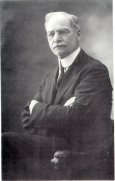 |
H.F. Reynolds |
"I did not know that we placed such importance on mission work from the beginning of our history. The Church of the Nazarene was involved in missions before it was even the Church of the Nazarene!" -- Brian Burdick, Northwest Nazarene University student
As several smaller movements were coalescing or coming together to become the Church of the Nazarene, two global visionaries emerged to nurture and shape the missionary vision and strategy of the new denomination. They were both from the Pentecostal Church of America group in the East: H. F. Reynolds and Susan Fitkin.
In 1908, three "holiness" movements united in Pilot Point, Texas, to form what has become the Church of the Nazarene. That new denomination did not have to start a global outreach program. It already had one going. All three of those groups had overseas missionary work, with the East (Pentecostal Churches of America) and the South (Holiness Church of Christ) being the most active.
At the time of that 1908 union, one of the most widely-known names in early Nazarene missions was already on a foreign mission field. The previous year, 1907, Harmon Schmelzenbach had left what would become Southern Nazarene University to go to Africa. There, he would remain -- without a furlough -- until he came home to speak to the 1928 General Assembly. After the assembly, though he was in frail health, he insisted on returning to Africa. There, he died the following year. [ more on Schmelzenbach ]
In 1908, H.F. Reynolds (from the Association of Pentecostal Churches of America, located in the eastern USA) emerged as the denomination's missionary outreach administrator. He took on the task of integrating the work of the three groups into one movement. H.F. Reynolds also became one of the General Superintendents. Though filling those dual roles was a heavy workload, the passion for world evangelism that Reynolds brought to his position as General Superintendent may have assured that world missions in the Church of the Nazarene did not become a stepchild relegated to a corner.
In 1913-14 H.F. Reynolds made an around-the-world trip. He was away from the U.S. for an entire year, visiting every Nazarene mission field. That trip set a precedent. Because of that, today, we would think it strange if Nazarene General Superintendents were not going on overseas trips to visit mission fields and ordain ministers.
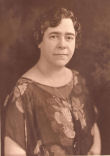 |
|
Susan Fitkin |
Susan Fitkin also came from that group in the Northeast. Early in life, she felt a call to missions service. She assumed the Lord wanted her overseas and applied to a mission board. They turned her down for health reasons. She didn't become bitter but turned her energy instead to being a world missions advocate and and mobilizer. In 1899 Susan Fitkin organized the Women's Foreign Missionary Auxiliary for the group of holiness churches in the Northeast. In 1915, when the Church of the Nazarene got around to officially organizing an auxiliary to raise awarenes and financial and prayer support, they turned to Susan Fitkin to lead it. She led that organization for the next three decades. That organization's presidency has never been a paid position. In fact, Susan Fitkin used a lot of her personal money for travel and even to fund missions projects overseas.
In 1923, the denomination moved to a centralized budget system (called General Budget for decades and now the World Evangelism Fund). Using one cooperative fund signaled an end to some administrative chaos and endless fund-raising appeals to local churches by numerous "general boards." That was a forward-thinking move that would keep the denomination stabilized and on track through the Great Depression.
Through those Great Depression years, the world missions administrative leader (as distinct from the awareness and support raising role of what is now the NMI) was J. G. Morrison. During those lean financial times, he repeatedly begged Nazarenes: "Can't you do just a little bit more?"
Early on, Nazarenes fell in love with great slogans and challenging goals. During the war-torn 1940s, Nazarene world missions director C. Warren Jones popularized the reach toward "a million for missions:" the giving of a million dollars for missions in one year.
The end of World War II signaled some dramatic new things for Nazarene missions. The General Assembly heard its first "native" speaker. The year was 1948. The city was St. Louis, and the speaker was Alfredo Del Rosso, an itinerant holiness evangelist from Italy. [ more on Del Rosso ] Del Rosso's presence was dramatic in that it signaled a giant step forward in a process in which Nazarene church leaders in all countries would eventually become equal partners in denominational affairs. [ Missionary stories from Italy ]
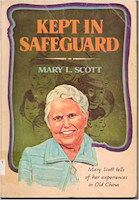 |
Mary Louise Scott |
During World War II, some Nazarene missionaries were interned by the Japanese in the Philippines and in China. One of the internees in China, Mary Scott, came home after her release at the end of the war to head what is now Nazarene Missions International.
In the U.S., a saturation church-planting mentality took early Nazarenes into county after county. Today, there are Nazarene churches in more than 80% of the U.S. counties, a far greater penetration than many denominations several times our size. Overseas, that same energy and vision has taken us to country after country. That movement into new areas accelerated through the 60s, 70s, and 80s and exploded in the 1990s. By the 2001 Nazarene General Assembly, the denomination was present in ministry in 138 countries or world areas. We say "world area" because we count places like the Caribbean islands of Martinique and Puerto Rico as separate from France and the U.S., even though they are not separate countries.
By the 1970s, the internationalization of church government began taking on clear outlines. That process had its beginning, however, more than a half-century prior to that. Back in the 1920s, the decision was made that General Superintendents would preside at all district assemblies. The people who made that decision may not have realized what the outcome would eventually look like, but with that decision, they put all districts worldwide on the same footing. In a time when colonial powers ruled the world, this decision was one in the opposite direction.
 |
Jerald Johnson |
Under Jerald Johnson's leadership in the 1970s, the denomination adopted a four-step process by which districts worldwide could attain the same status as districts in the U.S., Canada, and Great Britain. The first district outside of those three countries to achieve this status was in Guatemala. The Japan district probably should have been the first. They had applied to become a regular district in the 1930s, but the denomination's General Board was caught off guard then. They did not know what to do with a "mission field" district that wanted to send delegates to the General Assembly.
The development of Regional Offices in the 1980s shifted a great deal of decision-making from our Global Ministry Center in Kansas City (USA) to offices in places like Argentina, Panama, Singapore, Germany, and South Africa. That decentralization has helped us to administratively deal with the rapid pace of entering new countries.
We Nazarenes are in an audacious undertaking. Except for Roman Catholicism, no other denomination is trying to be a truly international one. Almost everyone else is opting for a loose federation of national churches or an American church with outposts elsewhere in the world rather than the tight-knit international model that we and the Roman Catholics are using.
The Church of the Nazarene today has congregations in more than 160 countries. Two-thirds of the Church of the Nazarene members now live outside the U.S.A./Canada region. We have worked hard to keep from creating financial dependencies, which hasn't always been easy.
Generally, funding from our World Evangelism Fund is directed toward start-ups and one-time projects. We stopped subsidizing pastors' salaries on mission fields a few decades ago. We may help a church with land purchase. We do help with building construction. In countries with a pastoral pension program established, we may help with matching funds. We may provide good pastoral training programs at low cost. We may help with travel costs to conferences of various kinds. We may help with medical emergencies. We may help with evangelistic campaigns such as JESUS film showings. As you can see, most of these things are one-time, grant-like expenditures rather than regular, ongoing subsidies.
We insist that all local Nazarene churches everywhere contribute to our global World Evangelism Fund. This is set at about 5.5% of their total local church income and is the same percentage worldwide. In some countries, that doesn't amount to very much money in terms of U.S. dollars, but it does broaden their focus from local outreach to include the global harvest field to which God is calling all of us. It gives all Nazarene churches worldwide "ownership" of our World Missions outreach.
We have tried to find ways to give people an incentive to fund their own programs locally. One of those is by treating Nazarfenes worldwide as equal partners and giving them a voice and opportunities for service in our governmental structure. We set up four stages or levels through which districts (groupings of churches) pass as they move toward full self-support. Districts get increased authority and voice in the international structure at each level or phrase.
We have also developed a multi-national missionary force that today has people from more than fifty countries in it. Some of the best motivators for encouraging local incentive have been people going from countries worldwide to serve as Nazarene global missionaries.
Another thing that has been helpful to us has been the de-centralizing of our organization. Almost all funding, missionary assignments, and other similar decisions are now made in regional offices. I think this also keeps people from looking to the USA as a principal source of financial support.
Their growth really reflects what has happened to us worldwide since we moved away from subsidizing local churches. We've seen more aggressive evangelism and much greater spiritual maturity as those subsidies have been phased out.
Some time ago, retired missionary Bill Porter spoke to one of my classes at Southern Nazarene University. Among the changes he said he has seen in Nazarene missions is that our decisions are no longer decided by money. He said that he remembered times when finances were the key factor in deciding when the Church of the Nazarene would enter a new country. Now, he says, when an opportunity presents itself, we move and expect God to provide the resources from somewhere. That's a good move, isn't it? It's a healthy move. It's a great day to be involved in fulfilling the Great Commission. Ends of the earth, look out! Here we come.
Today, the Church of the Nazarene is present in ministry in about 165 world areas. There are now more than 2.7 million members of the Church of the Nazarene.
1C. Gordon Olsen. What in the world is God doing? The essentials of global missions. Cedar Knolls, NJ: Global Gospel Publishers, 1989, p. 110.
2Thomas Coates. "Were the Reformers mission-minded?" Concordia Theological Monthly, 40:9, p. 604.
"God is summoning millions of believers to serve as senders with the same zeal and consecration of life purpose as front-line missionaries" -- Ralph Winter
Nazarene missions around the world: For strategic reasons, Nazarene missions leaders have divided the globe into regions. New outreach, as well as existing work in previously-entered areas, is administered from an office in each region. A Regional Director appointed by the General Board works closely with a General Superintendent in directing Nazarene ministry in that geographical area. [ more on regional structure development ] Each region is divided into "fields," with a Field Strategy Coordinator coordinating outreach and ministry in each of them.

The largest region in terms of members is Africa. The one reporting the smallest number of members is Asia-Pacific. The six regions with the locations of the regional offices are:
"We are surrounded by such a great cloud of witnesses . . ." -- Hebrews 12:1
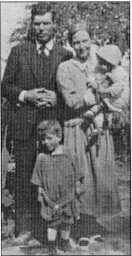 Roger and Esther (Carson) Winans, Peru, 1914-1948 |
 Ora Lovelace, Africa, 1919-1944 |
 Fairy Chism, Swaziland, 1928-1949 |
 A 1914 photo of Myrtle Mangum (far left), Sela Hargrove (third from left), and other missionaries in India, including L.S. and Gertrude Tracy and her mother, Ella Winslow Perry, with the three Tracy children: Olive, Martha and baby Albert Philip |
 Elizabeth Cole, Swaziland, 1935-1973 |
 Louise Robinson Chapman, South Africa, 1920-1942 |
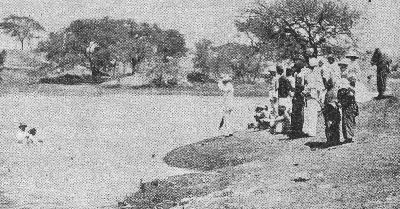 L.S. Tracy baptizing a convert in India |
 Paul Orjala who, with his wife Mary, opened Nazarene work in Haiti in 1950 |
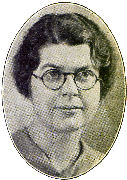 Orpha Speicher, India, 1936-1977 |
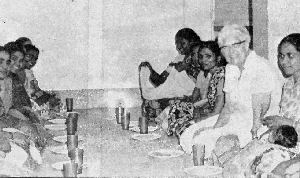 Orpha Speicher at a meal in India |
"Your labor in the Lord is not in vain." -- 1 Corinthians 15:58
-- Howard Culbertson, hculbert@snu.edu
| The Church of the Nazarene was born when a number of small associations of churches banded together . . . [ more ] |